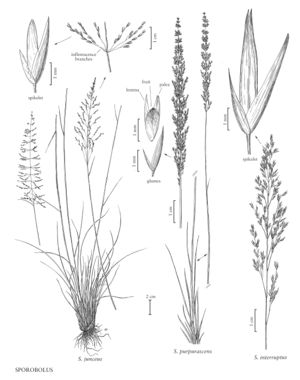Sporobolus junceus
Plants perennial; cespitose, not rhizomatous. Culms (30)40-100 cm. Sheaths rounded below, margins and apices sometimes sparsely ciliate; ligules 0.1-0.2 mm; blades (6)10-30 cm long, 0.8-2 mm wide, flat to tightly involute, glabrous abaxially, scabridulous adaxially, margins scabrous, apices pungent. Panicles 7-28 cm long, 2-6 cm wide, open, pyramidal; lower nodes with 3 or more branches; primary branches 0.7-4.5 cm, spreading 20-100° from the rachis, whorled or verticellate, without spikelets on the lower 1/8–1/2; secondary branches appressed; pedicels 0.4-2.5 mm, appressed, scabridulous. Spikelets 2.6-3.8 mm, purplish-red. Glumes unequal, linear-lanceolate to lanceolate or ovate, hyaline to membranous; lower glumes 0.9-3 mm; upper glumes 2.6-3.8 mm, as long as or longer than the florets; lemmas 2-3.6 mm, ovate, membranous, glabrous, acute; paleas 2-3.6 mm, ovate, membranous; anthers 1.4-2 mm, purplish. Fruits 1.4-1.8 mm, ellipsoid, somewhat laterally flattened, somewhat rugulose, reddish-brown. 2n = unknown.
Distribution
Va., Okla., Miss., Tex., La., Ala., Tenn., N.C., S.C., Ark., Ga., Ariz., Fla.
Discussion
Sporobolus junceus grows in openings in pine and hardwood forests, coastal prairies, and pine barrens, usually in sandy to loamy soils, at 2-400 m. Its range lies entirely within the southern United States.
Selected References
None.
